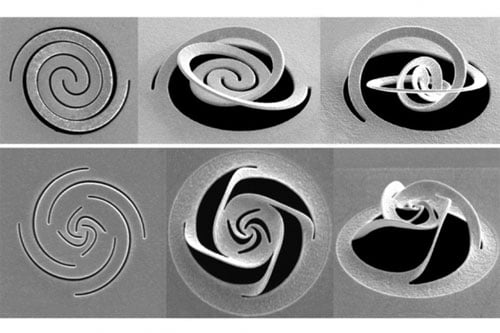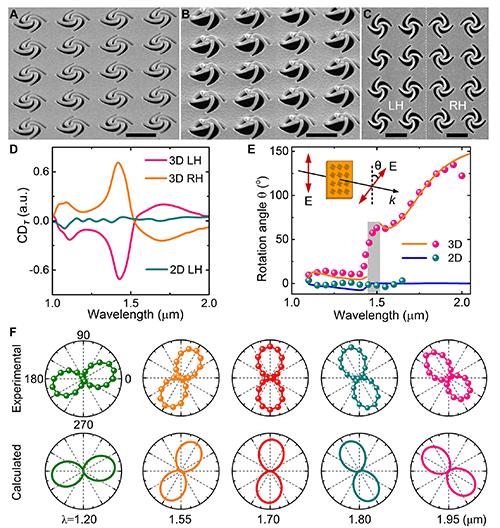Researchers from Massachusetts Institute of Technology (MIT) and the Institute of Physics (IOP) worked together to develop the technique. Using methods based on standard microchip manufacturing technology, the researchers used a focused ion beam (FIB) — instead of the knives and scissors used in kirigami — to cut a precise pattern of slits in a free-standing gold nanofilm. They used the same FIB (in the same way hands are used in kirigami) to gradually “pull” the nanopattern into a complex 3D shape that is capable of selectively filtering out light.
 Different patterns of slices through a thin metal foil (a gold nanofilm), are made by a focused ion beam. These patterns cause the metal to fold up into predetermined shapes, which can be used for such purposes as modifying a beam of light. Courtesy of the researchers from MIT.
The “pulling” forces were induced by heterogeneous vacancies (introducing tensile stress) and the implanted ions (introducing compressive stress) within the gold nanofilm during FIB irradiation. By using the topography-guided stress equilibrium within the nanofilm, versatile 3D shape transformations such as upward buckling, downward bending, complex rotation, and twisting of nanostructures were precisely achieved.
Different patterns of slices through a thin metal foil (a gold nanofilm), are made by a focused ion beam. These patterns cause the metal to fold up into predetermined shapes, which can be used for such purposes as modifying a beam of light. Courtesy of the researchers from MIT.
The “pulling” forces were induced by heterogeneous vacancies (introducing tensile stress) and the implanted ions (introducing compressive stress) within the gold nanofilm during FIB irradiation. By using the topography-guided stress equilibrium within the nanofilm, versatile 3D shape transformations such as upward buckling, downward bending, complex rotation, and twisting of nanostructures were precisely achieved.
In contrast to previous attempts to create functional kirigami devices, the new nanodevices can be formed in a single folding step and could be used to perform a number of different optical functions.
For a proof-of-concept demonstration, the team produced a 3D pinwheel-like structure with giant optical chirality. The nanodevice achieved efficient manipulation of “left-handed” and “right-handed” circularly polarized light and exhibited strong uniaxial optical rotation effects in telecommunication wavelengths.
The nanokirigami technique could open a new direction for emerging kirigami research.
“It’s a very nice connection of the two fields, mechanics and optics,” said MIT professor Nicholas X. Fang.
 Functional designs of nanokirigami structures with giant optical chirality. Courtesy of Institute of Physics.
The team also developed a theoretical model to elucidate the dynamics during the nanokirigami fabrication, which will help other researchers design 3D nanogeometries based on desired optical functionalities. With the equations the team has developed, other researchers should now be able to calculate backward from a desired set of optical characteristics to produce the precise pattern that is required for the optical effect they are seeking.
Functional designs of nanokirigami structures with giant optical chirality. Courtesy of Institute of Physics.
The team also developed a theoretical model to elucidate the dynamics during the nanokirigami fabrication, which will help other researchers design 3D nanogeometries based on desired optical functionalities. With the equations the team has developed, other researchers should now be able to calculate backward from a desired set of optical characteristics to produce the precise pattern that is required for the optical effect they are seeking.
Fang said that in previous work, “people were always trying to cut by intuition” to create kirigami patterns that could produce the desired effect.
Researchers believe that the nanokirigami concept could be extended to broad nanofabrication platforms and could lead to the realization of complex optical nanostructures for sensing, computation, micro- and nanoelectromechanical systems, or biomedical devices.
The research is still at an early stage, but the nanokirigami devices are orders of magnitude smaller than conventional counterparts that perform the same optical functions.
The research was published in Science Advances (doi:10.1126/sciadv.aat4436).
Nanokirigami with giant optical chirality. Courtesy of Massachusetts Institute of Technology.
